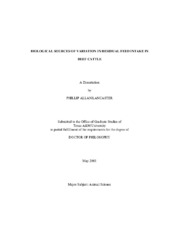| dc.description.abstract | Objectives of this study were to characterize residual feed intake (RFI) in
growing calves and to examine relationships with growth, carcass composition,
physiological indicators, energy metabolism and reproduction. To accomplish these
objectives, multiple experiments were conducted. In all experiments, RFI was calculated
as the difference between actual DMI and expected DMI from linear regression of DMI
on mid-test metabolic BW and ADG. To examine the relationships between RFI and rate
and composition of growth, and reproduction an experiment was conducted with
postweaning Brangus heifers (N = 348). Measures of carcass composition (longissimus
muscle area, LMA; and 12th rib fat thickness, BF) were obtained by ultrasound at the
start and end of each experiment. To determine if serum IGF-I concentration is
associated with RFI, two experiments were conducted with Angus bulls and heifers (N =
95) divergently selected for serum IGF-I concentration. To evaluate relationships with
energy metabolism, calves with low and high RFI were selected for determination of
heart rate as an indicator trait for energy expenditure (4 experiments) and liver
mitochondrial function (3 experiments). Residual feed intake was not correlated with ADG, but was positively correlated
with gain in BF such that the more efficient calves were leaner. Calves from the low
IGF-I selection line had lower RFI suggesting that RFI and IGF-I are related and that
IGF-I could be used as an indicator trait to aid in selection for improved RFI in Angus
cattle. Calves with low RFI had lower energy expenditure and greater mitochondrial
acceptor control ratios than calves with high RFI suggesting improved regulation of
energy metabolism. A similar percentage of heifers with low RFI attained puberty as
those with high RFI by the end of the experiment. Results from this study indicate that
producers can utilize RFI to select for improved feed efficiency with minimal impact on
growth, carcass composition and reproduction. | en |


